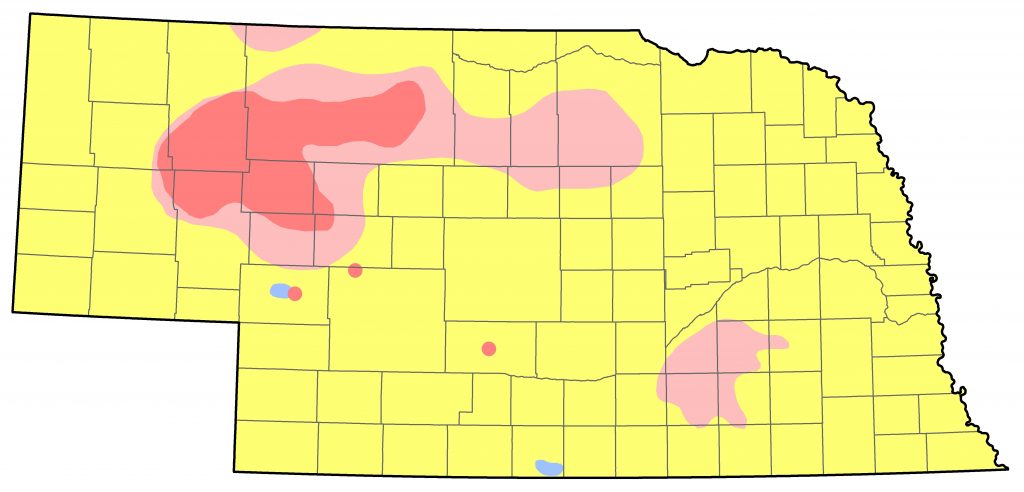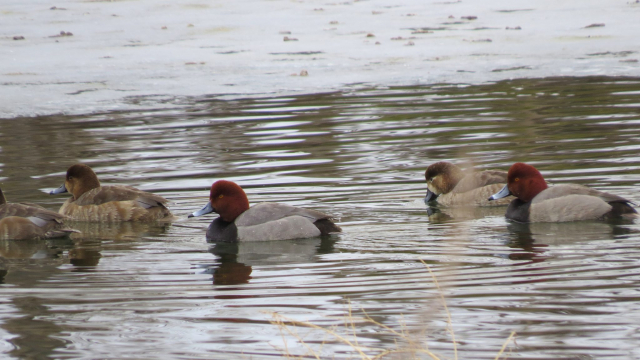Aythya americana
Status: Common, locally abundant, regular spring and fall migrant statewide. Common regular breeder north central and northwest, rare Rainwater Basin, rare casual elsewhere. Uncommon casual summer visitor away from breeding range. Uncommon regular winter visitor west, south, east, rare casual north.

Documentation: Specimen: UNSM ZM7678, 27 Mar 1932 McCook, Red Willow Co.
Taxonomy: No subspecies are recognized (AviList 2025).
This species hybridizes with others; for Nebraska records see Canvasback x Redhead, and Redhead x Ring-necked Duck.
Spring: winter <<<>>> Jun 14, 15, 15
Spring migration begins as water opens, when the low numbers of wintering birds are enhanced as migrants arrive, generally in mid-Jan. The 130 on 15 Jan 2003 at Lake Ogallala, Keith Co and 209 there 29 Jan 2000 were good early counts. Peak numbers occur in late Mar and migration is usually over by early May, although stragglers occur into early Jun or even later; most likely these are non-breeding immatures, as exemplified by up to five (two males, three females) still present 27 Jun 2021 and a male lingering through 19 Jul at Salerno Marsh/N 264th St, Douglas Co.
Later Jun-Jul dates away from the expected breeding range are discussed below under Summer.
Rosche (1982) considered the species to be a “very abundant” spring migrant (more than 1000 per day) in the Panhandle, noting large concentrations on Box Butte Reservoir, Dawes Co, and Smith Lake, Sheridan Co. Rosche (1994) also noted high concentrations on Lake McConaughy, Keith Co (High Counts). An impressive estimate of 40,500 was made in the eastern Rainwater Basin 31 Mar-1 Apr 2001.
- High counts: 40,500 in the eastern Rainwater Basin (34,000 of these at Harvard WPA, Phelps Co) 31 Mar-1 Apr 2001 (Jorgensen 2012), 15,000-20,000 at Lake McConaughy 21 Mar 1993 (Rosche 1994) and 14,000 there 24 Mar 1989 (Rosche 1994).
Summer: There are few reports of breeding away from the Sandhills range; confirmed reports have occurred only in the Rainwater Basin and in Dawson and Keith Cos.
Breeding records in the Rainwater Basin are as follows. A hen and brood were in York Co 30 Jun-1 Jul 2001 (Jorgensen 2012), a nest with 12 eggs apparently of this species (12 adults were present) was at Harvard WPA, Clay Co 2 Jun 2007, a brood including five young was at North Lake Basin WMA, Seward Co 16 Aug 2015, two hens each with broods were observed at Marsh Duck WMA, York Co 9 and 16 August 2015 (Jorgensen 2016), and a hen and brood were in Fillmore Co 17 August 2019 (Jorgensen and Brenner 2019). The only other indications of breeding in the Rainwater Basin are an old record of eggs found in 1916 in Clay Co (Ducey 1988) and “confirmed” nesting in York Co but without details (Mollhoff 2001).
Apparently a first breeding record for Keith Co was the presence of “broods” below Keystone Dam 19 Jul 2003; a single was there 10 Jul 2012. In Dawson Co, a hen with a brood was photographed at Bittern’s Call WMA 2 Aug 2019.
There are multiple breeding season (Jun through early Sep) reports without confirmed breeding in the Rainwater Basin; since most molt migration is northward from breeding areas to large lakes (Baldassarre 2014) and both males and females occur in approximately equal numbers, these birds are probably one year old non-breeders (see Fall). Unusually large numbers of several hundred congregated in the Rainwater Basin throughout the summer of 2019 when wetlands held extensive water (Jorgensen 2019), including a breeding record (above); numbers peaked in late Jul (see Fall).
Reports are fewest away from the breeding range mid-Jun through early Sep; there are about 65 in all, but amazingly 18 of these occurred statewide in 2019 during a large influx that was most noticeable in the Rainwater Basin (Jorgensen and Brenner 2019; see Fall).
- Breeding phenology:
Eggs/Incubation: 1 May-14 Jul.
Nestlings: 17 Jul.
Dependent Fledglings: 4 Jun-19 Jul.
Fall: Sep 8, 11, 11 <<<>>> winter
There are earlier reports of small groups beginning in late Jun in the Rainwater Basin (see Summer). Nine were in Adams Co 26 Jun 2018, Funk WPA, Phelps Co, hosted 22-36 late Jun through mid-Jul in the years 1996-2000, as many as 126 were in the eastern Rainwater Basin 28 Jun 2003, and there was an influx into the Rainwater Basin beginning 27 Jun 2015, when 100 were estimated, peaking at 345 on 26 Jul; 242 of the latter were at Harvard WPA, but no evidence for breeding was noted. An even larger influx occurred in 2019 (Jorgensen 2019), when a total of about 725 were reported; peak count was 475 on 24 Jul and most had departed by mid-Aug (Jorgensen and Brenner 2019). An influx of 70 arrived at Lake Alice, Scotts Bluff Co 11 Sep 2023.
There are numerous additional reports statewide Jul-early Sep of small groups, most likely one-year-old non-breeders (see Summer) or possibly molt migrants. A male in eclipse plumage was in Sarpy Co 11 Jul 2025.
Timing of peak numbers of true migrants varies, but largest numbers mostly occur in Oct and most leave the state by the end of Nov; some remain into Dec and early Jan. The 360 at Lake Ogallala 31 Dec 2016 and 322 there 30-31 Dec 2011 were large numbers for those late dates.
Banding data show that birds from Saskatchewan and the Dakotas were recovered in Nebraska, presumably en route to Gulf of Mexico wintering areas (Baldassarre 2014).
- High counts: 3292 at North Platte NWR, Scotts Bluff Co on 10 Nov 1994, 2500 at Lake Ogallala, Keith Co 7 Nov 2024, 2104 at Crescent Lake NWR, Garden Co 27 Sep 1995, and 1950 at Lake Ogallala 1 Nov 2000.
Winter: Redheads occur regularly in midwinter (mid-Jan) at scattered locations in the North Platte and Platte River Valleys and southward, with irregular reports elsewhere in those river valleys and in the northeast. Mid-Jan reports may be of wintering birds or early migrants. Largest counts at regular locations are 130 at Lake McConaughy 15 Jan 2003, 60 at Lake Ogallala, Keith Co 25 Jan 2025, 28 at Carter Lake, Douglas Co winter 2014-2015, 24 at Scottsbluff WTP, Scotts Bluff Co 23 Jan 2015, and 15 at Harlan County Reservoir, Harlan Co winter 1999-2000.
The only Jan record for the north is of one with Ring-necked Ducks along Berry Bridge Road, Valentine, Cherry Co 31 Jan 2024.
Images
Abbreviations
NWR: National Wildlife Refuge
UNSM: University of Nebraska State Museum
WMA: Waterfowl Management Area (State)
WPA: Waterfowl Production Area (Federal)
WTP: Water Treatment Plant
Literature Cited
AviList Core Team, 2025. AviList: The Global Avian Checklist, v2025. https://doi.org/10.2173/avilist.v2025.
Baldassarre, G. 2014. Ducks, geese, and swans of North America. Johns Hopkins University Press, Baltimore, Maryland, USA.
Ducey, J.E. 1988. Nebraska birds, breeding status and distribution. Simmons-Boardman Books, Omaha, Nebraska, USA.
Jorgensen, J.G. 2012. Birds of the Rainwater Basin, Nebraska. Nebraska Game and Parks Commission, Lincoln, Nebraska, USA.
Jorgensen, J.G. 2016. A summary of 2015 breeding bird surveys of selected Rainwater Basin wetlands. Nongame Bird Program of the Nebraska Game and Parks Commission, Lincoln, Nebraska, USA.
Jorgensen, J.G. 2019. The Summer Of Redheads. Blog post, Birds of Nebraska – Online, 8 Aug 2019.
Jorgensen, J.G., and S.J. Brenner. 2019. Notable avian nesting records from the Rainwater Basin, Nebraska — 2019. Nongame Bird Program of the Nebraska Game and Parks Commission, Lincoln, Nebraska, USA.
Mollhoff, W.J. 2001. The Nebraska Breeding Bird Atlas 1984-1989. Nebraska Ornithologists’ Union Occasional Papers No. 7. Nebraska Game and Parks Commission, Lincoln, Nebraska, USA.
Rosche, R.C. 1982. Birds of northwestern Nebraska and southwestern South Dakota, an annotated checklist. Cottonwood Press, Crawford, Nebraska, USA.
Rosche, R.C. 1994. Birds of the Lake McConaughy area and the North Platte River valley, Nebraska. Published by the author, Chadron, Nebraska, USA.
Recommended Citation
Silcock, W.R., and J.G. Jorgensen. 2025. Redhead (Aythya americana). In Birds of Nebraska — Online. www.BirdsofNebraska.org
Birds of Nebraska – Online
Updated 19 Aug 2025

